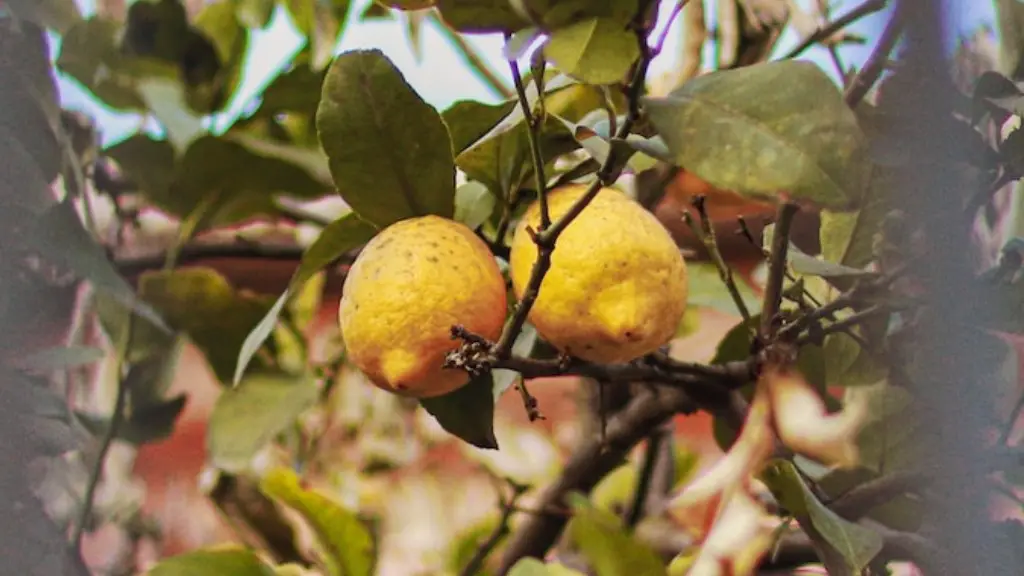The majority of lemon tree problems are preventable with proper maintenance and cultivation techniques. Supporting your lemon tree’s branches is necessary to ensure its health and to promote its growth. Here are several ways to support lemon tree branches:
1. Pruning is one of the most important steps in supporting lemon tree branches. Pruning will encourage healthy roots, leaves and fruits, and will reduce unnecessary stresses on the tree that could lead to damage. Prune in late winter or early spring, when the tree is dormant.
2. Regular fertilization is important for lemon trees and supports their development. Use a slow-release fertilizer applied in spring, late summer, and winter.
3. Planting is another important step in supporting healthy lemon tree branches. Plant in the early spring after all danger of frost has passed. Planting during this time will maximize the amount of time and energy that the tree can spend towards growth and development.
4. Watering is also an essential factor in supporting healthy lemon tree branches. Make sure that the tree is getting enough water, but not too much. Water deeply and regularly, or follow a regular pattern depending on the weather.
5. Mulching is an important factor in supporting lemon tree branches. Applying mulch around the tree will help prevent weed growth, keep roots cool, retain moisture, and feed the soil.
6. Protection from weather is also important for supporting lemon tree branches. Lemon trees can suffer from frost, hail and other extreme weather conditions, so providing some form of physical protection can help mitigate some of these risks.
7. Loosening is essential for supporting healthy lemon tree branches. Loosen the soil around the tree occasionally to help air and water penetrate the soil. Loosening the soil may also help prevent certain diseases and pests.
Methods To Support Unstable Lemon Tree Branches
Sometimes, lemon tree branches may be weak or damaged for any number of reasons. In this case, additional support may be necessary to keep them from breaking. One way to do this is to use stakes or trellises. Stakes should be placed at a 45-degree angle to the trunk, and the branches should be secured using plant ties or twine. This will help keep the branches from breaking. Another way to support unstable lemon tree branches is to use tomato cages. Place a tomato cage around the tree, and secure the branches to the cage using string or twine.
Tree shelters can also be used to support weak lemon tree branches. Tree shelters are made of plastic and are designed to protect the tree from wind, cold and pests. They also provide additional support for the branches, which helps to keep them from breaking or bending. Additionally, tree shelters can be used to protect delicate trees from extreme weather conditions, such as hail or frost.
Branches can also be straightened with a variety of tools, such as jacks and cables. Jacks can be placed at the base of the tree and used to gently pull the branches back into place. Cables are also used to straighten branches by attaching them to the main trunk. It is important to use the proper technique and be gentle when using jacks or cables, as violent pulling can cause the branches to break.
Advantages of Supporting Lemon Tree Branches
Supporting your lemon tree’s branches has several benefits for the health of the tree. For starters, it reduces the risk of damage from extreme weather conditions, such as hail or wind. Additionally, it can reduce the risk of disease, as it ensures that air and water can reach the leaves. Furthermore, providing adequate support can ensure that the tree has plenty of room to grow, and it can help the tree to bear fruit in a timely manner.
Supporting lemon tree branches can also help prevent sunburn and leaf scorch. Sunburn and leaf scorch can occur when the leaves are exposed to extreme temperatures and UV radiation. Providing support to the branches can help to prevent this, as it will provide added stability and protection to the leaves.
Finally, providing support to your lemon tree’s branches will help to improve the aesthetic of your garden. Lemon trees are known for their bright, beautiful flowers and fruits, and keeping the branches in good shape will enhance the natural beauty of your landscape.
How To Measure Lemon Tree Branches
Lemon tree branches should be measured in order to determine their size and shape. This can be done by using a tape measure or ruler. When measuring the branches, start at the center of the tree, and measure outwards in both directions. This will allow you to measure the length of the branches from the base of the tree to the end of the branches. It is important to include leaves and fruit when measuring, as this will provide an accurate measurement of the overall size and shape of the branches.
Once you have measured the branches, you should pay attention to the shape and thickness of the branches. Look for any bend or kinks in the branches, as these can be signs of damage. Additionally, you should look for any new buds or shoots that may be growing on the tree. These can indicate that the tree is healthy, and they are a sign that the tree is in good shape.
Finally, you should periodically inspect the branches for any signs of disease or pests. Diseased or unhealthy branches can be removed in order to improve the overall health of the lemon tree. Additionally, pests can cause damage to the branches, which can lead to stunted growth. By regularly inspecting the branches, you will be able to ensure that the lemon tree is healthy and strong.
Warnings Regarding Supporting Lemon Tree Branches
It is important to be mindful when supporting lemon tree branches. Over-pruning can lead to a number of problems, and it is important to use the proper techniques when pruning. Additionally, over-fertilizing can also be detrimental to the health of the tree, so it is important to use the proper amount of fertilizer. Furthermore, over-watering can lead to root rot and other diseases, so it is important to water only when necessary.
It is also important to avoid using harsh chemicals or treatments on lemon tree branches. These chemicals can cause damage to the tree and may even inhibit growth. If using any chemical or treatment, it is important to take heed of the manufacturer’s instructions and to use the product sparingly.
Finally, it is important to be mindful of the amount of weight being placed on the branches. Placing too much weight on the branches can cause them to break, so it is important to be careful when supporting the branches. If the branches become weak, it is best to use jacks or cables to gently pull them back into place.






Nice and informative article!! Cheers